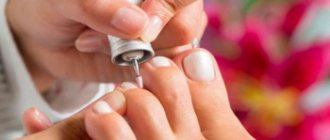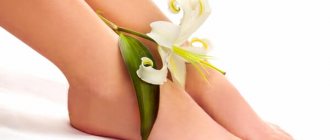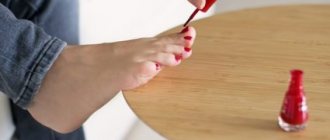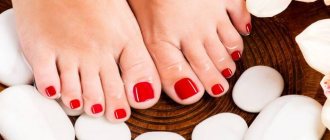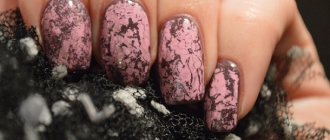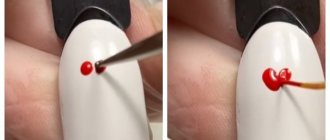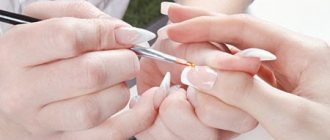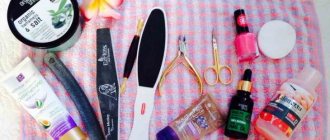General recommendations
A pedicure at home for beginners can be done using regular polish or gel polish. The first option is inexpensive and easy to apply, but such a coating is very short-lived and will last no longer than 3-5 days. Gel polish is more durable and will remain unchanged for 2-4 weeks, but it costs much more.
And to dry such a coating, you will need a special lamp, as well as a top and base. A beautiful pedicure can be either monochromatic or multi-colored. It can be supplemented with decorative elements or drawings. But in any case, a pedicure is not just painting with varnish. This procedure involves caring for the skin of the feet, because even the most beautiful design will look unattractive with rough heels.
What is a pedicure with gel polish
Gel polish is quite often used to cover toenails. It has become much more popular than regular varnish, gel or biogel. This is due to its gentle effect on the nail plate and long-lasting results.
The main advantages of this coating:
- If all rules are followed, the result will last for at least 3 weeks;
- its application, unlike conventional gel, does not require strong grinding of the nail plate;
- ease of use, it is easy to apply and remove;
- after removal, nails quickly recover;
- large selection of shades and effects;
- protects nails from the negative effects of the external environment.
Techniques and methods
There are several types of pedicure that can be applied at home:
| View | Peculiarities | Advantages | Flaws |
| Classical | Steamed feet are treated with pumice, a razor or a grater. The cuticle is trimmed with scissors and the nails are polished with a nail file. | The technique is simple and a beginner can master it. To perform a pedicure you need simple and affordable products. | There is a high risk of skin injury. If you use undisinfected instruments, you can get infected. Often the procedure accelerates the growth of rough skin. |
| European or unedged | The cuticle is not cut out, but softened with a special compound, and then pushed back. The rough skin is removed using special graters. | The technique is safe and virtually eliminates the risk of injury or infection. | The procedure is extremely delicate, so it will take 5-6 sessions to tidy up neglected feet. |
| Hardware | It is performed using a special device and milling attachments. The legs are not steamed before the procedure. | This type of pedicure is safe and effective. The feet remain soft for a longer period. | The apparatus for the procedure is quite expensive. In addition, it requires some experience to use it. |
| Acid | The feet are treated with a special composition containing fruit acid. After this, the dead skin is removed with a file. | The method is safe and allows you to get rid of any corns and calluses. The acid product is inexpensive and can be easily used at home. | Do not use if there is fungus or wounds. After the procedure, the skin often peels off for 5 days, which looks unattractive. |
For beginners, it is advisable to stick to the unedged method.
It consists of the following stages:
- Preparation.
- Removing dead skin.
- Filing of nails.
- Skin moisturizing.
- Coating.
Required materials and tools
To do a pedicure at home, you will need the following:
- Scissors, tweezers, nippers. It is important to choose sharp tools made from quality steel.
- File . For filing nails, it is advisable to choose a glass file. But it’s better to sand the surface with a buff.
- Pumice . As an alternative, you can use a special pedicure machine or a fine-grain grater to remove rough skin.
- Ceramic or plastic container for steaming legs.
- Towel , cotton swabs and discs.
- remover .
- Emollient cream or oil, scrub.
- Finger spacers and wooden stick.
- Sea salt , herbal decoctions or a special emollient for heels.
You will also need varnish or gel polish, as well as decorative elements if they are used to create a pedicure.
Preparation
At the initial stage, it is necessary to remove the remnants of the old varnish. After this, you need to steam your feet in a warm bath. Then the rough skin will soften, and subsequently it can be easily removed.
To enhance the effect, you can add different ingredients to the water:
- Sea salt . Strengthens nails and promotes rapid softening of the skin. Goes great with essential oils.
- Baking soda. Kills germs and is used to treat and prevent foot fungus. Excellent at removing unpleasant odors. For 3 liters of water, 4 tbsp is enough. l. soda
- Chamomile or calendula decoction . Adding these products not only disinfects and softens the skin, but also relieves stress. To prepare, pour 2 tbsp of boiling water into a glass. l. vegetable raw materials, leave to infuse for 30 minutes.
If the skin on your feet is very rough, you can take an express bath. To do this, add a few tablespoons of table salt to the water. Next, you need to soak your feet in this solution for 5-10 minutes, and then pour 2 tbsp there. l. hydrogen peroxide.
The resulting reaction will help quickly remove even severe calluses and corns. After 10 minutes of this bath, you can proceed to the pedicure itself.
How to perform the procedure
Pedicure at home for beginners is carried out according to the following algorithm:
- Steamed feet should be dried with a towel. After this, you should remove the rough skin using a pumice stone, a machine or a nail file. Movements should be smooth and careful. Particular attention should be paid to corns and keratinized areas. To remove dead cells from your fingers, you need to treat them with a scrub.
- After peeling, you need to wash your feet and apply nourishing cream or oil to them. To ensure that the products are better absorbed, it is advisable to massage the skin for 5-10 minutes.
- Using a wooden stick, you need to move the cuticle and then remove dirt from under the nails. This procedure must be carried out extremely carefully so as not to injure the skin.
- Using tweezers or scissors, you need to trim your nails. But don’t be too zealous at the edges, otherwise they will grow into the skin later. In general, it is better to trim your nails in a straight line, without touching the tips. After this, you should file the edges, giving them a slightly rounded shape. The upper surface of the nail needs to be polished with a buff.
All that remains is to apply the coating, which can be matte, glossy, with a design or plain - it all depends on your imagination and the desired result.
Softening rough skin
Pour the softening liquid into the bowl. After this, lower your legs into it. Some people prefer to use refillable formulations. They look like varnishes or pencils. These products lubricate the cuticle around the nail plate. Under the influence of the unique composition, the skin softens. After this, you can remove it without much difficulty.
Softening the cuticle with the help of special means requires a strictly specified time. Some formulations require exposure to the skin for 15 minutes, others act after just 5. If you do a pedicure at home with your own hands (an easy way for beginners), you will most likely choose softening with water. This effect on the skin should occur within 20 minutes.
Monochromatic pedicure master class
The monochromatic finish looks attractive and is suitable for everyday pedicures. Those who want to stay on trend should choose coral color. It will be at the peak of popularity in the autumn-winter season. Shades of blue, beige, red, gray, as well as classic black and white do not go out of fashion.
Those who love unusual tones should choose purple, fuchsia, burgundy, gold, orange, mint. Neon varnishes are popular in the last season. They look catchy and defiant, and are suitable for a club or beach look.
A plain pedicure with rubbing, shimmer or glitter looks no less impressive. This coating looks festive even without additional decor, and is suitable for an evening look. If desired, you can cover only one nail with glitter, and paint the rest with glossy varnish of the same shade.
The matte monochromatic finish looks stylish and elegant. For the approaching autumn season, burgundy shades will be especially relevant.
How to do a plain pedicure:
- After preparing the feet, it is necessary to treat the plates with a degreaser to remove any remaining cream or oils from them.
- Then you need to apply the base to your nails, and after waiting for it to dry, cover it with varnish in 2-3 layers. Each of them is applied only when the previous one has dried.
- The coating needs to be secured with a finish, then the result will last longer.
Options in different shades
Pedicure at home for beginners can be made bright and memorable if you use a technique such as gradient or ombre. It is based on the play of color, and can be created from several shades that smoothly flow into each other.
To create such a design you will need the following:
- 2-3 shades of varnish of the same or different color schemes, but suitable for each other;
- sponge;
- base, fixer.
To make a gradient pedicure at home, you need to treat your nails with a base. Then you need to apply varnishes of different colors to the sponge. The strokes should be as close to each other as possible. While the polish is still wet, you need to quickly transfer it from the sponge to your nails using patting movements. Beginners should remember that the result must be secured with a topcoat.
The gradient on all nails looks no less impressive. In this case, a different varnish of the same color is applied to each plate, starting from lighter on the thumb and ending with dark on the little finger.
Step-by-step instruction
In order for a gel polish pedicure to please you for as long as possible, you must follow the application technique.
- Firstly, the nail plate must be healthy. If there are signs of fungal infection, the nails are peeling, treat them first.
- High-quality treatment of fingers and nail plates ensures the durability of the coating.
Preparation:
- completely remove the previous coating;
- push back the cuticle;
- clean the nail plate from irregularities and detachments, sand it with a buff to remove gloss;
- remove cuticles and hangnails with a machine or scissors;
- remove dust thoroughly.
Coating:
- degrease your nails with primer;
- apply the base coat, leveling it with a brush, dry under the lamp;
- cover the nail with colored gel, dry each layer thoroughly;
- apply the finishing top, be sure to “seal” the edge of the nail to avoid chipping and peeling;
- remove the sticky layer if necessary.
The design can be done both on the top and before it is applied.
Removal:
- Gel polish cannot be removed with nail polish remover. To do this you will need a special product for shellac.
- Initially, it is necessary to remove a thin layer of coating with a medium-grain file. Then apply a cotton pad soaked in liquid to each nail and wrap it in foil.
- After 10 minutes, remove all this, the gel polish will soften, it can be removed with a manicure spatula.
Those who prefer a hardware pedicure can remove the coating by grinding with a machine.
Pedicure master class with simple patterns and drawings
Even without artistic skills, you can make a beautiful pedicure with a variety of designs. Moreover, there are several different painting techniques that even beginners can handle.
Using tape
Thanks to this material, you can create geometric shapes, diagonal or vertical lines, thin or wide stripes. To do this, you need to cover your nails with varnish of the main color.
After waiting for the layer to dry completely, you need to stick strips of tape to the plate so that you get the desired design.
The photo shows an example of a manicure, but a pedicure is done in a similar way. After this, you need to cover your nails with varnish, the color of which contrasts with the base. After waiting for the layer to dry, you should carefully tear off the tape and secure the result with a finishing coat.
Drawing with a needle
The simplest design can be made using 2 varnishes of a contrasting color and a regular needle. And you will also need a fixer to work.
Algorithm of actions:
- Apply base polish to prepared nails. Before moving on to the next step, you need to wait until the layer is completely dry.
- On the nail you need to put several dots of varnish that contrasts with the base. Then you need to stretch the needle through these points, drawing monograms and curls.
- When the pattern is dry, you should cover the nail with the finish.
And you can also use a needle to draw thin lines or outline a pattern.
Dots drawings
It is easier to draw patterns with dots than with a needle. After all, with the help of the tool you can control the volume of the drop, which makes the lines even. To create a design, you need to apply a base polish to the nail. And after waiting for it to dry, you should dip the dots “ball” in a contrasting color, and then apply the desired design with it.
Tulle lace
Using a piece of old tulle you can make a lace pattern on your nails. This pattern looks gentle and elegant, and is suitable for both festive and regular pedicures.
Execution algorithm:
- Apply a base to prepared nails and then cover it with a layer of varnish. It is worth considering that it will be the main color in the design.
- After waiting for the polish to dry, you need to apply a piece of tulle to the nail. Then you need to paint the material with varnish of a contrasting color.
- You should wait until the layer is completely dry and carefully tear the tulle away from the nail.
- The obtained result must be secured with a finish.
If desired, this design can be decorated with rhinestones, sparkles or crystals. Then the pedicure will turn out to be more festive.
Skin care using the device
Take the coarsest nozzle and treat especially problem areas with it. These are heels, dry calluses and corns. After this, use the nozzle to gently go over the entire skin. Remember that when doing a hardware pedicure, you can’t stop at one place. A rotating file can severely damage the skin. That is why all movements must be made carefully, moving slowly in a certain direction.
Once the rough layer of skin has been removed, you need to put on the sanding attachment and complete the pedicure. This type of file can be used to process the inside of the toes and the center of the foot.
Pedicure master class with decor
A pedicure at home for beginners can be done with the following decorative elements:
- rhinestones;
- kamifubuki;
- foil;
- stickers;
- metallized strips;
- stamping.
It is worth considering that you should not overload your nails with decor. Otherwise, the design will look vulgar.
Rhinestones and crystals
Similar decorative elements come in different colors and sizes. They look solemn and festive, and you can lay out entire paintings from them. But rhinestones and crystals quickly come off, so they are not recommended for everyday pedicures. But for an evening look they are irreplaceable.
To make a pedicure with rhinestones and crystals, you need to attach these decorative elements to the finishing coat that has not yet dried. If necessary, they can be covered with another layer of transparent top.
Kamifubuki
This is what colored confetti or sequins are called. Similar decorative elements can be either round or unusual in shape (triangles, stars, hearts).
And they can be used both as single decorations and to create compositions. Kamifubuki, like rhinestones, are attached to the finishing coating. They are suitable for summer design and look impressive against bright and dark backgrounds.
Foil
With foil you can make an original and unusual pedicure that will look appropriate in both everyday and festive looks. And with this decor you can decorate one or more fingers, or in general, highlight some part of the plate.
To do a pedicure with foil, you need to prepare your nails and then attach the decorative sheet to the still wet polish. If desired, you can make various patterns by drawing them with a colorless base. You need to wait 1-2 minutes, and then tear off the foil with a sharp movement.
Stickers
Stickers and sliders help you create an unusual design in a matter of minutes, and even a child can use them. The main thing is to remember that it is advisable to apply white or nude varnish under such decor. It is advisable to treat the top of the stickers with a transparent fixative.
If this decor is used for a pedicure with gel polish, then it must be attached to a non-dried topcoat. And only then should you dry your nails under a lamp. After completing work, avoid contact with water for 30 minutes. Then the stickers or sliders will look perfect for 15-20 days.
Metallized strips
This decor is ideal for creating geometric motifs that have not gone out of fashion for several seasons.
Stripes also help to hide the joints between two contrasting colors of varnish, for example in a French jacket, and they can be used for both everyday and festive looks.
Stamping
Stamping is the application of patterns using stamps. This technique helps you create an unusual and original pedicure in a matter of minutes. It is necessary to apply a base, preferably matte, to the prepared nails. Then the drawing will turn out clear and bright.
You need to apply a bright varnish to a plate with an ornament or pattern, and then use a stamp to transfer it to your nails. You won't be able to get uniform patterns the first time, so you'll have to practice. At the end, be sure to secure the result with a colorless finish.
What to do with your nails?
How to do a pedicure at home with your own hands? The step-by-step instructions say the following. The nail plate, like the rest of the skin, must be treated using attachments. However, they are smaller in size and have a different shape. Gently file away the cuticle without affecting sensitive areas and delicate skin.
The surface of the nails must be sharpened using a special attachment. After this, polish. Finally, you can apply the coating.
Fashion trends in 2019
Monochrome pedicure remains fashionable. Moreover, it is not necessary that it repeat the color of the nails on your hands. On the contrary, such a combination is considered provincial. For those who don’t particularly like a monochromatic pedicure, you can diversify the design with a pattern on one or more fingers.
As for shades, bright colors are in fashion: coral, green, gold, transparent blue. Lovers of a discreet style should choose burgundy or wine red. These colors look especially impressive in a matte pedicure.
In 2022, complex and intricate patterns are no longer in fashion. They were replaced by unobtrusive, simple drawings, but at the same time thought out to the smallest detail. Geometry, abstraction and funny prints, polka dots, flowers and ornaments are trending. Those who prefer laconicism should choose an ultra-fashionable marble pedicure.
The classic French jacket never goes out of style and remains relevant this year. But instead of the traditional white color, it is recommended to use red, blue, and golden shades for stripes. Lunar nail art is popular.
This year, the hole can be designed either traditionally oval or triangular, double or unfolded. Moreover, even beginners can easily handle this technique at home. If desired, such a design can be decorated with rhinestones or a metallic strip. But here it is important not to overdo it with the decor, otherwise the pedicure will look vulgar.
Article design: Oleg Lozinsky
Treatment of fingers in hardware pedicure.
Treatment of the nail plate.
| Special cylindrical cutter for free edge. In order to avoid damage to nearby tissues, this attachment is coated with sapphire exclusively at the end. | |
| Diamond cutter, truncated cone. Multifunctional nozzle. One of the application options is to treat the free edge of the nail. | |
| Cylindrical cutter with longitudinal perforated serrations made of stainless steel. Perfectly solves the problem of gryphosis. Can be used to process the free edge. | |
| Brush (brush) to clean the free edge. | |
Cuticle treatment. | |
| Spherical diamond bur. Convenient and safe to use. | |
| The only-clean cutter is a special cutter made of tool steel with a polygonal working surface for removing ptegirium. It can be used both on a dry nail plate and after applying a cuticle remover. | |
| Corundum cutter for polishing cuticles. Depending on the abrasiveness, it is used both in the cuticle area and for grinding the skin of the periungual space. | |
| Brush (brush) for polishing the cuticle after treatment with the only-clean nozzle. Apply cuticle remover before use. | |
Treatment of nail folds. | |
| A needle-shaped carbide cutter with a fine cross cut is a good helper in the fight against hard rollers. This cutter is suitable for making cuts during the treatment of an ingrown toenail. | |
| Diamond cutter with a truncated cone with a rounded end of varying abrasiveness. The choice of cutter abrasiveness depends on the condition of the skin. The rougher the skin, the larger the abrasive on its working part. The photo shows medium abrasive. | |
| Pear-shaped sapphire cutter. Works delicately on the skin, including the cuticle area. The abrasive of the sapphire head is medium or fine. | |
Treatment of calluses on toes. | |
| MonAlit diamond cutter - tornado. This cutter is manufactured using a unique technology, forming a monolithic structure consisting almost entirely of diamond grain. This cutter gently grinds the skin without injuring it, forming an ideal, smooth surface, while the skin DOES NOT HEAT! This attachment is indispensable when working with diabetic feet. | |
| Steel cutter, truncated cone, perforated. This cutter, despite its menacing appearance, can be safely used to speed up work. | |
| To work with calluses, you need to have burs of different diameters (from 1mm to 3mm). When drilling the callus canal, we change the burs, starting with a larger one, gradually moving to a bur of a small diameter. Metal spherical bur with transverse notches. | |
| Metal spherical bur with longitudinal notches, for drilling calluses. | |
| The sapphire pear-shaped cutter gently completes the treatment of calluses, leaving a flat and smooth surface. | |
| Bud-shaped carbide cutter with fine cross-cut and titanium nitride coating for delicate processing. The coating increases the cutting efficiency of the working surface of the nozzle. | |
| A carbide cutter with a large cross-shaped cut and coated with titanium nitride is effectively used not only with artificial materials (acrylic, gel) but also with leather. | |
| Rubber base with replaceable cap. Effective grinding. Diameter from 5mm to 13mm. Used to remove calluses on fingers. The choice of cap abrasive (coarse, medium and fine) depends on the condition of the skin. The thinner the skin, the finer the abrasive. | |
Polishing. | |
| Felt for polishing nails and skin. Felt perfectly polishes the nail plate and skin. | |
| It is possible to apply oil before polishing. | |
| The cotton pad removes dust and gently polishes nails and skin. A very pleasant procedure for the client, which can be used to complete the procedure. It is advisable to apply oil before polishing. | |
| Silicone bullet-shaped cutter for polishing skin and nails. | |
